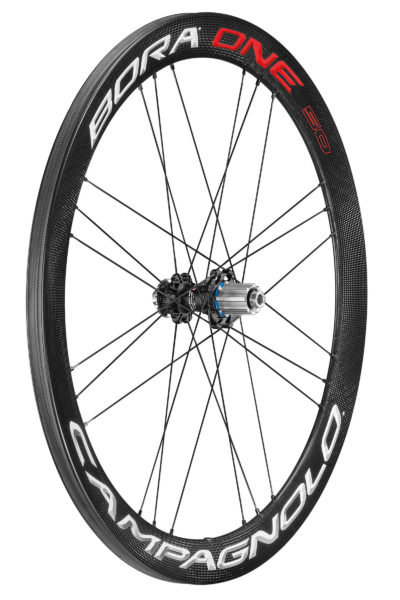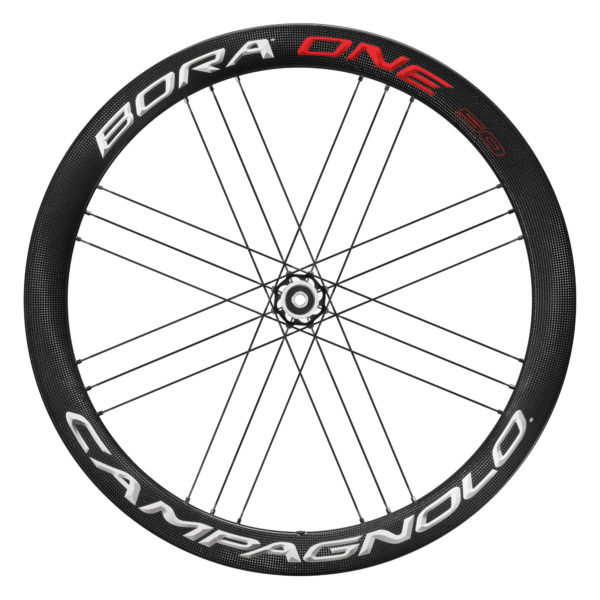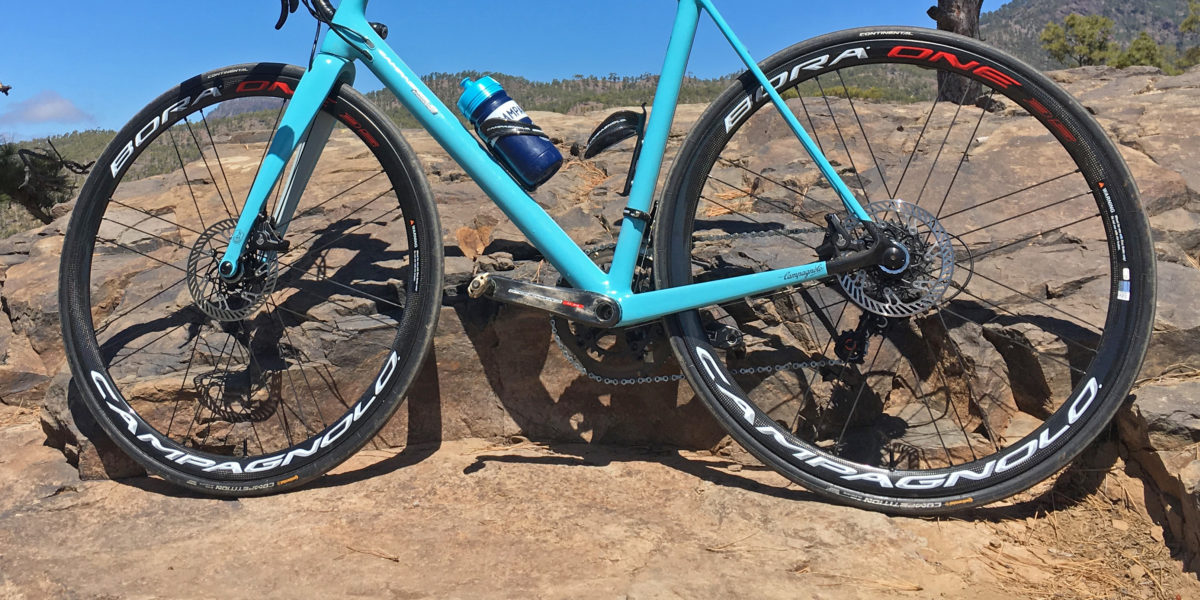By now we all know that Campagnolo has gone all in with road disc brake, from pro race-ready carbon components (assuming the cliques in the peloton won’t turn their noses up at you) down to an alloy groupset that mere mortals can afford, yet still offers the same brake performance. With their Zonda aluminum wheels covering the affordable spectrum and everyday alloy Shamal Ultra wheels delivering on tubeless, there was still a need for a dedicated race day Campagnolo disc brake wheel. Enter the Bora One. Starting with a slightly wider C17 profile, the new carbon wheels in tubular & clincher versions and 2 depths, offer premium disc brake performance with the updated disc brake specific rims and construction…
Like the Shamal family in aluminum, Campagnolo has grown and evolved the carbon Bora line-up since it was debuted back in 1994 into a series of race wheelsets focusing on high performance, but also delivering on long-term durability.
The new Bora One Disc Brake carbon wheelsets in tubular & clincher again take Campy developed tech and reimagine it for disc brakes. Like the Shamal Ultra DB, the Bora One DBs use G3 lacing alternating front to back which side gets the spokes doubled up. The doubled number of spokes of G3 on the front wheel was a pretty obvious decision to handle the asymmetric braking forces, with the disc side benefiting from both the crossed spoke layout and the extra spokes.
On the rear wheel the configuration was a bit more complicated. The first thought was to add spokes to the non-drive/disc side, but that then negated the more balanced spoke tension that G3 provides in the rear because of the steeper angle of the driveside spokes making way for the cassette. When Campagnolo studied the rear torsional forces in two different directions put into the hub by braking and drivetrain power transfer, they realized that with a one-piece alloy hub shell (instead of a three-piece with a carbon body) they could effectively transfer the less rear brake’s forces into the hubshell and oversized driveside spoke flange while maintaining the traditional benefits of G3 behind the cassette.
With standard bladed stainless steel spokes, Campy chose to go with 24 spoke lacing front & rear, with 16 on the disc side at the front and driveside at the rear, with 8 spokes across the centerline of the wheels.
35mm
New alloy hubs with oversized flanges and updated G3 straight pull spokes was one thing, but the rims needed overhauling as well. Without the need for a brake track Campagnolo went about completely reworking the Bora in their two most popular depths – 35 & 50mm.
The 100% made in-house by Campagnolo in Europe carbon rims for the most part kept the same external shapes, but they were able to slightly tweak the aero shape nearest the tire where there was no longer a need for a straight section for brake pads to bite into. Inside everything was reworked though as each of the individual laser-cut carbon plies were reshaped to deal with new G3 spoke forces, and new spoke hole layouts since Campy molds (not drills) the spoke holes for continuous fibers around the wheels. The end result was that each of the new disc brake carbon rims dropped weight over its rim brake sibling, even with the wider 17mm internal clincher and 24.2mm external tubular profiles optimized to support 25-28mm tires.
Like the Shamals, the Boras also use a MoMag construction that leaves the rim bed without spoke holes. That offers a much better gluing surface for the tubulars, but also makes for a stiffer, more structurally sound carbon rim than can get thinner wall thicknesses, and ends up lasting much longer. Campagnolo officially said that these carbon Bora clinchers are not tubeless ready, and then almost immediately we heard someone else under their breath say that they knew of many riders who were happily riding them with tubeless valves and not tubes, without any issues.
The Bora One DB 35 is available in 1297g tubulars (604g front/693g rear) for 1907€. Or you can get a set of 1509g Bora One DB 35 clinchers (703g/806g) for 2139€. All of the new wheels come stock set up for 12mm thru-axles, but with tool-free endcaps available aftermarket you can convert them for QRs as well.
50mm
Both depth carbon Bora wheels continue Campy’s use of a shiny UV-blocking resin that means they come out of the mold ready to ride, with no need for a clear coat – less paint, less weight. Like the premium alloy wheels the Bora Ones get dynamic balance, where Campagnolo molds in a structural counterweight opposite the valve stem to prevent wheel hop at high speeds. The wheels also use Campy’s standard easy-to-use micro setting hub bearing preload that you adjust with wheel on the bike and a simple turn of an allen key, and USB ceramic bearings.
The deeper Bora One DB 50 are only available for now in a 1364g set of tubulars(639g/725g) for 1907€, but Campagnolo seemed to suggest that a clincher version should be on its way in the future as well. They also alluded to the fact that even lighter Bora Ultra DB versions were likely in the design pipeline as well.
For the time being both 35mm & 50mm deep Bora One DB tubulars should be making their way into the supply chain as we speak, with availability by the end of May 2017. The 35mm clinchers are just a couple months behind them, anticipated in July 2017.
For an overview of our in-depth coverage of the Campy disc brake project:




